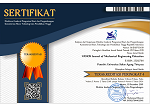Design of Soybean Epidermis Peeling Machine
Abstract
The process of stripping the soybean epidermis on tempe producers still uses the traditional method, namely by trampling the soybeans in the container until peeled. This causes the soybean to be crushed or split into two because the pressure exerted is unstable and unhygienic, need more time and effort. The aim of the study was to design a soybean epidermis peeler machine. The stages of the research were assessment, design, and validation design. The results of the research are machine designs with dimensions of length 505 mm, width 391 mm and height 815 mm with conventional pulley drives with crank manual working system and friction with capacity of 20 Kg/hour. The application of the machine soybean husk remover makes less effort is used and separation process of the skin from the soybean can be done more quickly so that it can increase production capacity.
Keywords
Full Text:
PDFReferences
J.L. Kiers, M.J.R. Nout, F.M. Rombouts, M.J.A. Nabuurs, J. Van Der Meulen, Inhibition of adhesion of enterotoxigenic Escherichia coli K88 by soya bean tempe, Letters in Applied Microbiology, Volume 35, Issue 4, 1 October 2002, Pages 311–315, https://doi.org/10.1046/j.1472-765X.2002.01182.x
Abiodun, P.O. (1991) Use of soya‐beans for the dietary prevention and management of malnutrition in Nigeria. Acta Paediatrica Scandinavica Supplement 374, 175–182.
Alvina, A., & Hamdani, D. H. (2019). Proses Pembuatan Tempe Tradisional. Jurnal Ilmiah Pangan Halal, 1(1).
Yusron, Muhammad., 2008, Rancang bangun Mesin Pengupas Kulit Ari dan Pembelahan Biji Kedelai Bahan Baku Produksi Tempe, Tugas Akhir, Politeknik Negeri Semarang.
Rofarsyam, Studi Eksplorasi Pembuatan Tempe pada Industri Kecil di Kabupaten Semarang, Mandegani Vol II No. 4, 2006, Politeknik Negeri Semarang.
Taufik, H., Pengujian Mesin Pengupas Kulit Ari Biji Kedelai Di Sentra Industri Tempe Bringin Salatiga Jawa Tengah, Dimensi, Vol. III No. 2, 2006, Politeknik Negeri Semarang.
Setiawan, S. B. (2012). Model Efisiensi Mesin Pengupas dan Pembelah Biji Kedelai Tipe Piringan Menggunakan Program Powersim. POSITRON, 2(2).
R. A. Anugraha, N. M. Darmawan, and M. Iqbal, “Best Concept Selection for Dry-Soybean Cracking Machine Process Optimization using TOPSIS method,” IOP Conf. Ser. Mater. Sci. Eng., vol. 528, no. 1, 2019.
Suryawinata, B, Perencanaan, Pembuatan dan Pengujian Mesin Pengupas Kulit Ari Kacang Kedelai. Jurusan Teknik Mesin Fakultas Teknologi Industri, Universitas Kristen Petra, Surabaya., 2006.
Ramadhani, I. (2016). Perancangan Mesin Pengupas Kulit Ari Biji Kedelai (Doctoral dissertation, Universitas Gadjah Mada).
H. Darmawan and Harsokoesoma, Pengantar Perancangan Teknik (Perancangan Produk), Politeknik Manufaktur Negeri Bandung, 2004.
M. S. Annas, Perancangan Mesin Pengupas Kulit Ari Kacang Kedelai, Universitas Trisakti, 2002.
Kristanti, D., Setiaboma, W., & Herminiati, A. Karakteristik Fisikokimia dan Organoleptik Cookies Mocaf dengan Penambahan Tepung Tempe (Physicochemical and Organoleptic Characteristics of Mocaf Cookies with Tempe Flour Additions). Biopropal Industri. 2020 Maret; 11(1): p. 1-8.
Wisnujati, A. Penerapan Ilmu Pengetahuan Dan Teknologi Mesin Pengupas Kulit Ari Kedelai Jenis Screw Pada Industri Kecil Tempe. Teknoin. 2016 Maret; 22(1): p. 09-18.
Gultom, Peniel. "Perancangan Mesin Pengupas Kedelai dengan Metode Wet Process Skala Home Industry." Industri Inovatif: Jurnal Teknik Industri 11.2 (2021): 66-70.
R. A. Anugraha, N. M. Darmawan, and M. Iqbal, “Best Concept Selection for Dry-Soybean Cracking Machine Process Optimization using TOPSIS method,” IOP Conf. Ser. Mater. Sci. Eng., vol. 528, no. 1, 2019.
Adini Alvina, and Dany Hamdani. Proses Pembuatan Tempe Tradisional. Jurnal Pangan Halal. 2019 April; 1(1): p. 9-12.
Romiyadi and Y. Dwianda, “Perancangan dan Pembuatan Mesin Pengupas Kulit Ari Kacang Kedelai Design and Manufacturing of Soybean Epidermis Peeler Machine,” vol. 9, no. 1. 2019.
Yunus, Made Arsana, Novi S.D., Erlinda Ningsih, “Designing and Fabrication of Integrated Soybean Machine (3 in Process) of Optimize Tempe Producers Productivity,” International Joint Conference on Science and Engineering 2021 (IJSE 2021), vol. 209.
Setyaningsih, Dwi. Analisis Sensori Untuk Industri Pangan Dan Agro. Bogor: IPB Press, 2010.
Wardjito, W., & Suyadi, S. Desain Rancang Bangun Mesin Pemecah Dan Pemisah Kulit Ari Kedelai Dengan Kapasitas 60 Kg/Jam Yang Terintegrasi Dalam Satu Proses Kerja. Wahana Teknik. 2013 Mei; 2(1): p. 32-39.
Kusnayat, A., Puspitasari, S. Y., Herdiani, A., Hafidh, M. Y. A., Sardi, I. L., & Martini, S. Implementasi Alat Pengupas Dan Penyaring Kulit Ari Kacang Kedelai Untuk Meningkatkan Kapasitas Produksi Tempe Cv. Mitra Pangan Sejahtera, Bandung. Charity: Jurnal Pengabdian Masyarakat. 2019 September; 2(1): p. 1-9.
Karudin, A., Basri, I. Y., Lapisa, R., Abadi, Z., Putra, R., & Ananda, O. (2022). Pelatihan Software Inventor Dalam Meningkatkan Kompetensi Guru Sekolah Menengah Kejuruan Di Sumatera Barat. Suluah Bendang: Jurnal Ilmiah Pengabdian Kepada Masyarakat, 22(1), 16-24.
Ashby, M. F., & Cebon, D. (2005). Materials selection in mechanical design. MRS Bull, 30(12), 995.
Hafiidh, M. Y. A., Kusnayat, A., & Febriyanti, E. (2019). Perancangan Mesin Pengaduk Untuk Memisah Kulit Ari Kedelai Menggunakan Metode Reserse Engineering. E-Proceeding of Engineering, 6(2), 6743-6749.
Susilawati, Buchori, A. (2019). Design and Application of Special Service Tools (SST) for Telescopic Front Fork. Jurnal Automotive Engineering. Vol.2. No.2, 53-5.
Maropoulos, Paul G., and Dariusz Ceglarek. "Design verification and validation in product lifecycle." CIRP annals 59.2 (2010): 740-759.
Sutejo, A., dan Prayoga, A. R., “Rancang Bangun Alat Pengupas Kulit Ari Kacang tanah (Arachis hypogaea) Tipe Engkol”, 2012, Jurnal Keteknikan Pertanian, Vol. 26, No. 2, 107 - 114.
Rianingtyas, A. K., & Wardani, K. K. (2019). Perancangan user Interface aplikasi mobile sebagai media promosi digital UMKM tour dan travel. Jurnal Sains dan Seni ITS, 7(2), 118-123.
Sularso and K. Suga, Dasar Perancangan dan Pemilihan Elemen Mesin, Cetakan ke-11, Jakarta: Pradnya Paramita, 2004.
DOI: http://dx.doi.org/10.30870/vanos.v8i1.17764
Refbacks
- There are currently no refbacks.

This work is licensed under a Creative Commons Attribution 4.0 International License.


.png)
.png)
